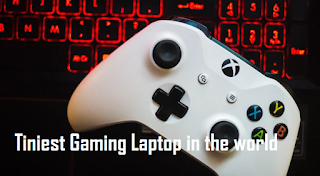It has no flashy plastic design, no RGB lighting, no overclocking and the performance isn't even very good. But make no mistake, the GPD Win Max arguably packs more PC gaming punch per liter than anything that's ever come before it, and I was lucky enough to be sent a pre-production unit. So, let's have a look at it together. Instantly see your current and past network activity, detect malware and block badly behaving apps on your PC or Android device, with Glass Wire. Use offer code Linus to get 25% off Glass Wire at the link below. (upbeat music) The first thing my wife said is that it reminds her of the Aspire One. Given the thickness of the GPD Max, and the cramped keyboard, that's not entirely an unfair comparison. But a lot was learned from the early netbooks and performance has come along way since Intel Atom. GPD ended up taking a shockingly ero compromises to approach to the Win Max, and the highlights of its specifications include, 16 Gigs of LPDDR4X memory, 512 Gigs of NVME storage, and eight-inch 500 nit display, lightning-fast Wi-Fi six, and enough IO to embarrass some laptops that are twice its size. But the star of the show is the 10 nanometer Intel Quad-Core processor, which manages to turbo up to three to 3.3 gigahertz, under light real-world all-core loads. Guys, that is just about the same base frequency, as a 4770 desktop chip.
And, it comes loaded with Iris plus graphics 940. Yeah, we were gonna have to get to that eventually. It uses onboard graphics, but as we've seen so many times before, a complete product can be more than the sum of its parts. Yes, my friends, that is GTA5 running on the Win Max. But hold on, it's worth talking about some of the set up first. One of the first things I did was pop into the BIOS and toggle the CPU's TDP o the maximum, 25 watts. It's pretty typical these days for Intel to have configurable thermal envelopes for their mobile chips, but usually, the device manufacturer will pick one for you and design a thermal solution that allows the chip to go as fast as it can, within that limit, not here.
Now it's a little kludgy and requires a reboot every time, but leaving this to the user, allows those folks who are mostly interested in retro-game emulation, to extend their battery life considerably, by tuning power consumption down or by disabling cores, while offering maximum performance, to those who are looking to play older Triple-A PC games or emulated games from much newer consoles. When it comes to real-world performance, other than a couple of misleading bits in the marketing, I'm thrilled, in truly heavy workloads, the 1035 G7 falls well behind a 4790K, let's be honest, but PlayStation 1 emulation was flawless, PlayStation 2 was superfluid, in fact, almost anything that's normally CPU-bound, even Dolphin which is notoriously CPU heavy, due to the Game Cube and whiz IBM processor, ran more like I would expect it to run on something that would fit in my lap, not something that would fit in my hand. Even GPE's representation of the PC gaming experience is pretty upfront. Modern demanding Triple-A games will run, as long as you don't mind cranking down the graphical settings and living with a 30-ish FPS experience. As for older Triple-A games, these run, oh it crashed. Yeah, it's an early unit and the firmware and the hardware are both not final. So, I did run into some issues here, but until it crashed it was running great.
I mean, it's crazy because I remember when you needed a top-tier gaming PC to run Batman Arkham Asylum. This thing though, you can basically max it out, running at 60 FPS, with only very occasional stutters, and that's at native resolution, and therein lies some of the magic. Built into the Win Max, is a HIPS panel that's rated for 500 nits max brightness, and runs at 1280 by 800 resolution. That is pretty low for a modern display, and if you have sharp eyesight the experience is not as good as they seem to make it out to be. In the Indiego go pitch, GPD points out, how the pixel pitch, the pixel density of their display compares to common laptop and desktop display sizes in pixel counts. The problem is that the way that you would typically hold the GPD max, puts it much closer to your face than those other displays. So you need more pixel density, for it to reach Retina levels, where you can't make out the individual pixels. I do understand the design limitations at play here though, it's not like the Iris Pro graphics.
We're gonna be able to drive anything higher than an HD panel anyway, and playing at a lower but still native resolution, is better the alternative, truthfully, I'd have done it the same way. I just felt that it was a little disingenuous to make the comparisons that they did. Some more good news though is that I love the built-in controller. As we've seen on previous GPD products, there's a rocker on the side that toggles the controller between mouse model with the shoulder buttons acting as left and right-click,and gamepad mode, which is a standard X Input, meaning that it usually requires no configuration to "just work." This is far and away from their best effort so far, the A, B, X, Y buttons are delightfully clicky but not loud. The D-pad is the best I've seen on anything that isn't a dedicated game controller, and the analog sticks, they might take up at on of space internally that might have been great to use for battery, but they were worth it. The tension on them is just right, the plastic ribbing on the top is the perfect balance of control and durability, and I got no annoying dead zones, putting me in perfect control all the time. If I had to complain about the gamepad, I would say the shoulder buttons are a little light for my taste.





![You are given a tree of N nodes, rooted at 1. You are also given two arrays A and P, where the value of node U is given by A[U] and the parent of node U is given by P[U].](https://4.bp.blogspot.com/-O3EpVMWcoKw/WxY6-6I4--I/AAAAAAAAB2s/KzC0FqUQtkMdw7VzT6oOR_8vbZO6EJc-ACK4BGAYYCw/w680/nth.png)



![You are given a tree of N nodes, rooted at 1. You are also given two arrays A and P, where the value of node U is given by A[U] and the parent of node U is given by P[U].](https://blogger.googleusercontent.com/img/b/R29vZ2xl/AVvXsEhTpF7Lra1VETER3Z5ALLUIjgIgMfUkS83xaaJWF8KpE6F-Nk3QV7Obo84o5oZ1_e3fueezIoqRjtjQdGCqi76966_xLVncEBNztPY0Cx3D2UhpqtUa4O4UOHIWai03Aqsv5io479qO6og/w680/nth.png)






0 Comments